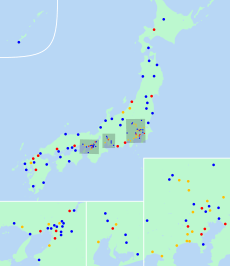Special cities of Japan facts for kids
A special city (called Tokureishi in Japanese) was a type of city in Japan that existed until 2015. These cities were quite large, each having at least 200,000 people. They were given some special powers and responsibilities that usually belonged to the larger prefectural governments. These powers were similar to, but a bit less than, those given to "core cities".
The idea of special cities was created by a law called the Local Autonomy Law. To become a special city, a city council and a prefectural assembly had to ask the government for this special status. The government would then officially name them a special city.
Because special cities and core cities had very similar powers, the government decided to change the law. On April 1, 2015, the category of special cities was removed. Now, any city with at least 200,000 people can apply to become a core city directly. Some special cities that weren't promoted right away can still keep their special powers for a while. They are called "special cities for the enforcement period" (Shikōji Tokurei shi), but this is only a temporary plan.
It's important to know that special cities were different from the special wards of Tokyo. They were also not the same as the "special (designated) cities" (tokubetsu-shi) that were planned between 1947 and 1956 but never actually happened. Those older "special cities" would have been completely separate from their prefectures, like the special wards are separate from Tokyo City. The special cities we are talking about here had more freedom than regular cities, but they were still part of their prefectures.
Contents
What Were Special Cities Like?
Special cities were given more control over things like public health, city planning, and welfare services. This meant they could make more decisions locally without needing approval from the prefectural government for every little thing. It helped them manage their large populations and services more efficiently.
Why Did They Change the System?
The main reason for changing the system was to make things simpler. Having both "special cities" and "core cities" with similar powers caused some confusion. By removing the special city category, the government aimed to create a clearer system for how cities are managed in Japan. Now, cities can aim for the "core city" status, which gives them even more local control.
List of Former Special Cities
When the special city category was removed in 2015, there were 23 cities that had this special status. Here is a list of those cities:
| Name | Japanese | Flag | Emblem | Area (km2) | Population (2012) | Date of designation | Region | Prefecture | Map |
|---|---|---|---|---|---|---|---|---|---|
| Atsugi | 厚木市 | 93.83 | 224,181 | 2002-04-01 | Kantō | Kanagawa | |||
| Chigasaki | 茅ヶ崎市 | 35.71 | 239,874 | 2003-04-01 | Kantō | Kanagawa | |||
| Fuji | 富士市 | 244.95 | 245,015 | 2001-04-01 | Chūbu | Shizuoka | |||
| Hiratsuka | 平塚市 | 67.88 | 260,061 | 2001-04-01 | Kantō | Kanagawa | |||
| Ibaraki | 茨木市 | 76.52 | 276,474 | 2001-04-01 | Kansai | Osaka | |||
| Isesaki | 伊勢崎市 | 139.44 | 207,253 | 2007-04-01 | Kantō | Gunma | |||
| Jōetsu | 上越市 | 973.81 | 202,366 | 2007-04-01 | Chūbu | Niigata | |||
| Kakogawa | 加古川市 | 138.51 | 268,175 | 2002-04-01 | Kansai | Hyōgo | |||
| Kasugai | 春日井市 | 92.78 | 306,573 | 2002-04-01 | Chūbu | Aichi | |||
| Kasukabe | 春日部市 | 66.00 | 236,976 | 2008-04-01 | Kantō | Saitama | |||
| Kishiwada | 岸和田市 | 72.68 | 197,629 | 2002-04-01 | Kansai | Osaka | |||
| Kumagaya | 熊谷市 | 159.82 | 201,814 | 2009-04-01 | Kantō | Saitama | |||
| Nagaoka | 長岡市 | 891.06 | 281,101 | 2007-04-01 | Chūbu | Niigata | |||
| Numazu | 沼津市 | 186.96 | 199,883 | 2000-04-01 | Chūbu | Shizuoka | |||
| Odawara | 小田原市 | 113.79 | 194,672 | 2000-04-01 | Kantō | Kanagawa | |||
| Ōta | 太田市 | 175.54 | 217,107 | 2007-04-01 | Kantō | Gunma | |||
| Saga | 佐賀市 | 431.84 | 237,501 | 2014-04-01 | Kyushu | Saga | |||
| Sōka | 草加市 | 27.46 | 244,851 | 2004-04-01 | Kantō | Saitama | |||
| Takarazuka | 宝塚市 | 101.89 | 227,617 | 2003-04-01 | Kansai | Hyōgo | |||
| Tokorozawa | 所沢市 | 72.11 | 344,194 | 2002-04-01 | Kantō | Saitama | |||
| Tsukuba | つくば市 | 283.72 | 244,528 | 2007-04-01 | Kantō | Ibaraki | |||
| Yamato | 大和市 | 27.09 | 230,357 | 2000-04-01 | Kantō | Kanagawa | |||
| Yokkaichi | 四日市市 | 206.44 | 306,107 | 2000-04-01 | Chūbu | Mie |
See also
 In Spanish: Ciudad especial de Japón para niños
In Spanish: Ciudad especial de Japón para niños


